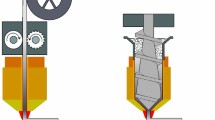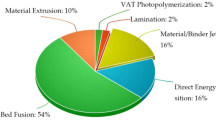Abstract
In the last half century, 3D printing – or additive manufacturing (AM) – has emerged as an efficient and cost-effective method for both large scale and consumer level manufacturing. While technology exists at the professional level for AM of metals, this equipment is cost-prohibitive for the average user, and as such the consumer field is mostly limited to plastics and some plastic-fiber composites. A promising area of study is in plastic-metal composite materials printed using material extrusion (MEX), which are sintered post-printing to remove the plastic binder and yield a solid metal part. One such material, a mixture of polylactic acid (PLA) and aluminum, would prove useful for several reasons. PLA is one of the easiest materials to produce with MEX, making it a good matrix for this composite. As well, aluminum is one of the most widely used metals in industry due to its low cost, high strength to weight ratio, and good corrosion resistance. Being able to additively manufacture parts using this method would avoid many of the limitations associated with traditional manufacturing, produce less waste material, and allow for the average consumer to produce functional and strong parts using readily available technology. However, little research exists on sintering aluminum parts produced with this method, with initial findings suggesting that the equipment and processes needed for this are outside the reach of the average consumer. This research study explores the feasibility of using this method to produce accurate and useable parts, examining the printing parameters to use for most reliable sintering and best post-sinter quality, along with what is needed to achieve successful sintering of printed parts.
Highlights
Surface roughness of aluminum-PLA composite filaments is affected by both print settings and the inherent roughness of the material.
Controlling oxidation of the aluminum is a main limiting factor in achieving successful sintering of parts.
Sintering of the material used in this study is more cost-prohibitive and technically challenging than initially expected, with materials and equipment required that are outside the scope of the average consumer.







Similar content being viewed by others
Data availability
Data are contained within the article.
References
Gupta, A., et al.: Material extrusion of thermoplastic acrylic for intraoral devices: Technical feasibility and evaluation. J. Mech. Behav. Biomed. Mater. 143, 105950 (Jul. 2023). https://doi.org/10.1016/J.JMBBM.2023.105950
Alifui-Segbaya, F., Ituarte, I.F., Hasanov, S., Gupta, A., Fidan, I.: Opportunities and limitations of additive manufacturing, Springer Handbook of Additive Manufacturing. Springer Handbooks. Springer, Cham. pp. 125–143, (2023). https://doi.org/10.1007/978-3-031-20752-5_9
Alkunte, S., Fidan, I., Naikwadi, V., Gudavasov, S., Ali, M.A., Mahmudov, M., Hasanov, S., Cheepu, M.: Advancements and challenges in additively manufactured functionally graded materials: a Comprehensive Review. J. Manuf. Mater. Process. 8(1):23 (2024). https://doi.org/10.3390/jmmp8010023
Sharma, G.K., Pant, P., Jain, P.K., Kankar, P.K., Tandon, P.: May, Analysis of novel induction heating extruder for additive manufacturing using aluminum filament. Proceedings of the institution of mechanical engineers, Part B: J. Eng. Manuf. 235, 12, pp. 1961–1970, (2021). https://doi.org/10.1177/09544054211014451
Liu, F., et al.: Mar., 3D printing of fine-grained aluminum alloys through extrusion-based additive manufacturing: Microstructure and property characterization, J Mater Sci Technol, vol. 139, pp. 126–136, (2023). https://doi.org/10.1016/J.JMST.2022.08.017
Aluminum 6061: Filamet™ | Metal 3D Print - The Virtual Foundry. Accessed: Aug. 28, 2023. [Online]. Available: https://shop.thevirtualfoundry.com/products/aluminum-6061-filamet?variant=15396457676883
Material Extrusion Processes | ASTM Standardization News: Accessed: Aug. 28, 2023. [Online]. Available: https://sn.astm.org/update/material-extrusion-processes-jf22.html
Fidan, I., et al.: Recent inventions in additive manufacturing: holistic review. Inventions. 8(4):103 (Aug. 2023). https://doi.org/10.3390/inventions8040103
De Seijas, O.V., et al.: Indirect induction sintering of metal parts produced through material extrusion additive manufacturing. Materials. 16(2):885. (Jan. 2023). https://doi.org/10.3390/MA16020885
Terry, S., Fidan, I., Tantawi, K.: Dimensional analysis of metal powder infused filament - low cost metal 3D printing. Proceedings of the 30th annual international solid freeform fabrication symposium. (2019). https://doi.org/10.26153/TSW/17291
Taha, B., Patil, S., Dennis, B.H.: Design and Manufacturing of Topology Optimized Heat Sinks Made of Copper Using 3D Printing, Proceedings of the ASME 2021 16th International Manufacturing Science and Engineering Conference, MSEC 2021, vol. 1, Aug. (2021). https://doi.org/10.1115/MSEC2021-63877
Korpe, N.O., Dürger, N.B., Dur, D., Celikyürek, I.: Effects of Compacting Pressure and Sintering Temperature on the Properties of Highly Porous Pure Aluminum Produced with Boric Acid (H3BO3), Powder Metallurgy and Metal Ceramics, vol. 59, no. 11–12, pp. 661–671, Mar. (2021). https://doi.org/10.1007/S11106-021-00201-9
Zhang, Z., Fidan, I.: Machine learning-based void percentage analysis of components fabricated with the low-cost metal material extrusion process. Materials. 15(12):4292 (Jun. 2022). https://doi.org/10.3390/ma15124292
Zhang, Z., Femi-Oyetoro, J., Fidan, I., Ismail, M., Allen, M.: Prediction of dimensional changes of low-cost metal material extrusion fabricated parts using machine learning techniques. Metals. 11(5):690 (Apr. 2021). https://doi.org/10.3390/met11050690
Terry, S., Fidan, I., Tantawi, K.: Preliminary investigation into metal-material extrusion. Progress Additive Manuf. 6(1), 133–141 (Feb. 2021). https://doi.org/10.1007/S40964-020-00151-5
Elgawad, A., Abdulaziz Al-Tamimi, A., Tlija, M., Haider Abidi, M., Anis, A., Elaty Abd, A.E., Elgawad: Material Extrusion of Multi-Polymer Structures Utilizing Design and Shrinkage Behaviors: A Design of Experiment Study, Polymers 2023, Vol. 15, Page 2683, vol. 15, no. 12, p. 2683, Jun. (2023). https://doi.org/10.3390/POLYM15122683
Qamar Tanveer, M., Mishra, G., Mishra, S., Sharma, R.: Effect of infill pattern and infill density on mechanical behaviour of FDM 3D printed Parts- a current review. Mater. Today Proc. 62, 100–108 (Jan. 2022). https://doi.org/10.1016/J.MATPR.2022.02.310
Original: Prusa i3 MK3S + 3D Printer kit | Original Prusa 3D printers directly from Josef Prusa. Accessed: Aug. 29, 2023. [Online]. Available: https://www.prusa3d.com/product/original-prusa-i3-mk3s-3d-printer-kit/
Portable Surface Roughness Tester: Accessed: Aug. 29, 2023. [Online]. Available: https://www.mitutoyo.com/webfoo/wp-content/uploads/Surftest_SJ-210_310.pdf
1200°C: Bottom-loading Vacuum Furnace (8.6ID, 7.6 Liter) with Gas Cooling Function -VBF-1200X-E8. Accessed: Aug. 29, 2023. [Online]. Available: https://www.mtixtl.com/VBF-1200X-E8-B.aspx
Acknowledgements
Thanks to Orkhan Huseynov, Mohammad Alshaikh Ali, and Marshall Norris for advising and helping on this project. Authors also want to thank Micah Midgett for his assistance running SEM analysis. Special thanks are conveyed to the Tennessee Technological University Creative Inquiry Summer Experience (CISE) grant program for funding this research study.
Funding
Funding for this research was provided by the Creative Inquiry Summer Experience (CISE) program at Tennessee Technological University.
Author information
Authors and Affiliations
Contributions
Both authors’ contributions to the tasks of the entire paper are equal.
Corresponding author
Ethics declarations
Conflict of interest
The authors declare that they have no conflict of interest.
Additional information
Publisher’s Note
Springer Nature remains neutral with regard to jurisdictional claims in published maps and institutional affiliations.
Rights and permissions
Springer Nature or its licensor (e.g. a society or other partner) holds exclusive rights to this article under a publishing agreement with the author(s) or other rightsholder(s); author self-archiving of the accepted manuscript version of this article is solely governed by the terms of such publishing agreement and applicable law.
About this article
Cite this article
Hudson, E., Fidan, I. The development of a framework to produce additively manufactured, low-cost aluminum via material extrusion process. Int J Interact Des Manuf (2024). https://doi.org/10.1007/s12008-024-01813-2
Received:
Accepted:
Published:
DOI: https://doi.org/10.1007/s12008-024-01813-2




